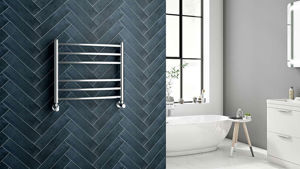Hard water contains high levels of calcium and magnesium salts, which are an essential part of our daily diet. When water is heated, the dissolved calcium and magnesium bicarbonates break down to form less soluble calcium and magnesium carbonates. These solidify and become limescale.
Limescale manifests as the nuisance deposits that appear around your taps and basin. It can also be visible on the base of your kettles in a flaky, chalk like form or even a thin layer of white film that might be visible on glassware from a dishwasher. Limescale from hard water is usually white but can become discoloured by traces of other minerals or metals. For example, traces of copper from plumbing materials can turn limescale grey, green or blue while traces of rust from pipe work can turn it orange, brown or even black. This can cause unsightly and lasting discolouration to your sanitary ware.
Installing a water softener into your home and following these simple steps can help reduce and even eradicate the build up of limescale.
Testing for Limescale
To test and confirm the presence of limescale, place some of the suspected limescale particles into a glass and add a few drops of ordinary vinegar or a solution of half a teaspoon of citric acid (lemon juice), dissolved in half a cupful of water. If limescale is present it should fizz slightly, giving off bubbles of harmless carbon dioxide gas.
How to Reduce Limescale in Kettles
There are few ways to reduce limescale in kettles, however you should always refer to the manufacturer’s instructions as to not cause any damage.
• Empty the kettle completely and rinse out every day if necessary
• Using a stiff nylon brush, you can carefully brush the inside of the kettle to dislodge any residue.
• Fill the kettle with a solution of vinegar and water and leave it for a few hours, rinse, boil and empty to remove the loosened limescale.
• Descaling solutions can be bought in most hardware shops, however always check these are suitable for use with your kettle.
You are more likely to see scale in water boiled in plastic kettles than metallic ones. This is because they are smoother and hold the scale less firmly.

How to Reduce Limescale in Dishwashers
Most dishwashers have a built in softener which automatically removes hardness from water and prevents the formation of limescale that can leave a dirty residue on your crockery. Always make sure you keep your dishwasher’s salt and rinse aid levels topped up as this will help to reduce limescale levels. If you have a problem with your dishwasher, it is always worth checking with the manufacturer as some dishwashers have a variable softener settings to suit water hardness levels.
How to Reduce Limescale in Hot Water Systems
In hard water areas central heating systems usually run off a self contained circuit with their own tank. This kind of system avoids limescale as it recycles the same water, containing a finite amount of calcium and magnesium carbonates which can precipitate out. Once all of the carbonates have precipitated, no more limescale will form. However, if your central heating uses the same circulation system as the household hot water it may be advisable to provide some degree of water treatment by adding a mini water softener that will prevent limescale from building up.
How to Reduce Limescale in Shower Heads and Taps
Limescale tends to build up in and around taps and shower heads that are fed from hot water systems. A classic symptom of limescale build up in a shower head is water squirting out in every direction but down. This is due to water being squeezed through the holes in the shower head which have become clogged with limescale. No amount of external cleaning can fix it. Shower heads and taps can be carefully descaled by using vinegar or a citric acid solution. Keeping your water systems temperature below 60c can also help to reduce limescale.
No matter how much effort you put into cleaning your shower head, it will amount to nothing if limescale deposits are present in your shower hose or pipes, it is important to clean these as well. Soaking your shower hose in hot water and vinegar can help to remove large build ups of limescale, if this does not help resolve the situation you may require the help of a plumber.
Vado offer an extensive range of shower heads that feature rubber nipples that sit proud of the main shower head, such as the Vado Aquablade Slim Line, Easy Clean Square Shower Head. This features rubber nipples that are evenly spaced for easy cleaning to reduce the build up of limescale. Vado taps that that feature a rubber aerator are ideal for hard water areas as they can be easily cleaned. Limescale sticks to the rubber, becomes hard and can be easily rubbed off.

How to Reduce Limescale by Polyphosphate dosing
You can reduce the build up of limescale by adding a chemical called polyphosphate to water, in the form of crystals, directly to the cold water header tank which feeds the hot water system. The hot water will be treated for up to six months. Although we do not recommend you drink water from the hot tap, polyphosphate is approved for use in drinking water and will not cause harm if used according to the instructions.






